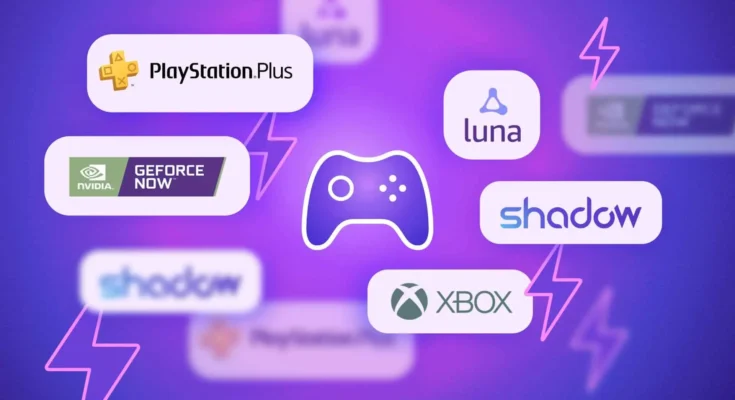Cloud gaming services are revolutionizing the gaming industry, offering players the ability to stream high-quality games directly to their devices without the need for expensive hardware. With the rise of high-speed internet, advancements in cloud computing, and increasing demand for flexible gaming solutions, cloud gaming is set to redefine how we play. This article explores the evolution, technology, benefits, challenges, and future of cloud gaming services in detail.
Evolution of Cloud Gaming
The concept of cloud gaming dates back to the early 2000s when companies began experimenting with streaming technology for video games. Early attempts included services like OnLive and Gaikai, which aimed to bring high-quality gaming to users without requiring powerful local hardware. However, these pioneers faced technological limitations such as latency issues and high operational costs.
With advancements in internet speed, data compression, and server technologies, cloud gaming has made significant strides in recent years. Major tech giants like Google, Microsoft, NVIDIA, and Sony have invested heavily in cloud gaming, bringing services like Google Stadia, Xbox Cloud Gaming, NVIDIA GeForce Now, and PlayStation Now to the forefront.
How Cloud Gaming Works
Cloud gaming operates on the principle of streaming games from remote servers to a user’s device. Instead of running games locally on a PC or console, cloud gaming services process game data in powerful data centers and transmit video and input signals in real time.
Key Components of Cloud Gaming Technology
- Data Centers – High-performance servers with GPUs and CPUs that process game logic, graphics, and physics.
- Streaming Protocols – Technologies that encode and compress game video before transmitting it to users.
- Client Devices – The end-user’s device, such as a smartphone, tablet, PC, smart TV, or console, which receives and displays the game stream.
- Internet Infrastructure – High-speed, low-latency internet connections that ensure smooth gameplay without noticeable delays.
Leading Cloud Gaming Services
1. Google Stadia
Google Stadia launched in 2019 as a cloud gaming service that allows players to stream games without needing a console or gaming PC. It supports 4K resolution and HDR, providing high-quality gaming experiences. However, Stadia faced challenges related to game availability and business model sustainability, leading to its closure in 2023.
2. NVIDIA GeForce Now
GeForce Now allows users to stream games they already own from platforms like Steam and Epic Games. It supports various devices and provides a high-performance experience, leveraging NVIDIA’s powerful GPU infrastructure.
3. Xbox Cloud Gaming (xCloud)
Microsoft’s xCloud is integrated with the Xbox Game Pass, offering a library of games that can be played on multiple devices. The service is backed by Microsoft’s Azure cloud computing technology, ensuring a seamless experience for gamers worldwide.
4. PlayStation Now
Sony’s PlayStation Now allows users to stream and download a selection of PlayStation games. It provides access to a vast library of older and newer titles, catering to both casual and hardcore gamers.
5. Amazon Luna
Amazon Luna offers cloud gaming with a subscription-based model that includes access to a variety of games. With support for Fire TV, Windows, macOS, and mobile devices, Luna integrates well with Amazon’s ecosystem.
Benefits of Cloud Gaming Services
1. Accessibility and Convenience
Cloud gaming eliminates the need for expensive gaming hardware. Players can access high-end games on various devices, including smartphones, tablets, and smart TVs, making gaming more accessible to a wider audience.
2. Cost Savings
Since games run on remote servers, users do not need to invest in expensive gaming PCs or consoles. Subscription-based models also provide access to a large library of games for a fixed monthly fee, reducing the cost of purchasing individual titles.
3. Seamless Cross-Platform Gaming
Many cloud gaming services allow players to continue their gaming sessions across multiple devices without losing progress. This cross-platform capability enhances the gaming experience and provides greater flexibility.
4. Instant Play and No Downloads
Unlike traditional gaming, which requires game installations and updates, cloud gaming allows instant access to games without lengthy downloads or patches.
5. Game Preservation and Scalability
Cloud gaming prevents issues related to hardware obsolescence, ensuring that games remain playable without the need for regular hardware upgrades. It also allows for easy scalability, where service providers can upgrade performance without requiring changes on the user’s end.
Challenges and Limitations
1. Latency and Internet Dependency
One of the biggest challenges in cloud gaming is latency. A stable, high-speed internet connection with low latency is essential for smooth gameplay. Users in areas with poor internet infrastructure may face lag, affecting the gaming experience.
2. Data Consumption
Cloud gaming consumes significant amounts of data, making it challenging for users with data caps or slow connections. Streaming at high resolutions, such as 4K, can require substantial bandwidth, leading to high internet costs.
3. Limited Game Libraries
Not all cloud gaming services offer the same selection of games. Licensing agreements and exclusive titles may limit availability, forcing players to subscribe to multiple services to access their favorite games.
4. Ownership and Digital Rights Issues
Unlike traditional game purchases, cloud gaming often follows a subscription model, meaning players do not own the games they play. If a service shuts down or removes a game from its library, players may lose access.
5. Regional Availability
Some cloud gaming services are not available in all regions due to legal restrictions, infrastructure limitations, or business decisions, limiting their accessibility to a global audience.
Future of Cloud Gaming
1. 5G and Edge Computing
The rollout of 5G networks and advancements in edge computing will significantly reduce latency and improve cloud gaming performance. This technology will allow for a more seamless experience, even on mobile networks.
2. AI and Machine Learning Integration
AI-driven optimizations will enhance game streaming quality, reduce bandwidth requirements, and improve in-game experiences. Machine learning can also help predict user behavior and adapt streaming settings for optimal performance.
3. Expanded Game Libraries and Partnerships
As cloud gaming grows, more game developers and publishers will partner with cloud services to expand game libraries and introduce exclusive content.
4. Hybrid Gaming Models
Some services may offer hybrid models, combining local processing with cloud gaming for better performance and reduced latency. This approach will enhance the experience for users with varying internet speeds.
5. Integration with Metaverse and VR
Cloud gaming could play a crucial role in the development of the metaverse, providing immersive virtual worlds with minimal hardware requirements. VR and AR gaming could also benefit from cloud-based processing.
Conclusion
Cloud gaming services are transforming the gaming industry by offering convenient, high-quality gaming experiences without the need for expensive hardware. While challenges such as latency, data consumption, and ownership concerns remain, technological advancements in 5G, AI, and edge computing are set to address these issues. As the gaming industry continues to evolve, cloud gaming is expected to become a dominant force, shaping the future of interactive entertainment.




